The x86 Power Myth Busted: In-Depth Clover Trail Power Analysis
by Anand Lal Shimpi on December 24, 2012 5:00 PM ESTSunSpider 0.9.1
Now the fun stuff. Doing power profiles of our standard benchmarks gives us good insight into how well each vendor was able to balance peak performance and average power. In general it's ok to burn more power for a short amount of time as long as it means you'll get to sleep quicker. This was one of the fundamentals of the first transition to mobile from the early 2000s.
We already know that Intel completes SunSpider quicker thanks to its improved memory subsystem over the Cortex A9, but it also does so with much better average power (3.70W vs. 4.77W for this chart). A big part of the average power savings comes courtesy of what happens at the very tail end of this graph where the W510 is able to race to sleep quicker, and thus saves a good deal of power.
| JavaScript Performance | |||||||
| Time in ms (Lower is Better) | Kraken | SunSpider | RIA Bench Focus | ||||
| Acer W510 (Atom Z2760 1.8GHz) | 33220.9ms | 730.8ms | 3959ms | ||||
| Microsoft Surface (Tegra 3 1.3GHz) | 49595.5ms | 981.1ms | 5880ms | ||||
| Samsung ATIV Smart PC (Atom Z2760 1.8GHz) | 33406.0ms | 721.3ms | 3752ms | ||||
| Apple iPad 4 (A6X) | 19086.9ms | 834.7ms | - | ||||
| Google Nexus 10 (Exynos 5 Dual) | 11146.0ms | 1384.1ms | - | ||||
I also used SunSpider as an opportunity to validate the results from Intel's tablets with my own review samples. To generate this chart I measured power, every second, at the wall with both devices plugged in and with a fully charged battery. The resulting power consumption numbers include the efficiency loss at the AC adapter but the general curve shoud mimic the results above:
Note that the results do generally line up, although measuring at the battery gives more accurate results for the device and using the NI DAQ I was able to get better granularity on the power measurements.
Looking at CPU level power consumption we see a very even match between Atom and Tegra 3. Intel's advantage really comes from being able to complete the workload quicker (0.52W compared to 0.72W on average).
Once again we see a pretty significant difference in power consumption on the GPU rail between these two platforms.
Kraken
Mozilla's Kraken benchmark is a new addition to our js performance suite, and it's a beast. The test runs for much longer than SunSpider, but largely tells a similar story:
RIABench
RIABench's Focus Tests are on the other end of the spectrum, and take a matter of seconds to complete. What we get in turn is a more granular look at power consumption:




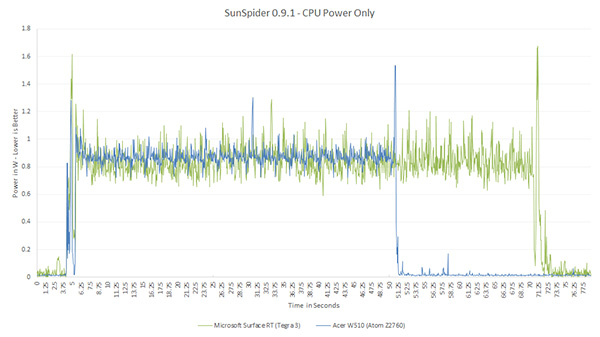

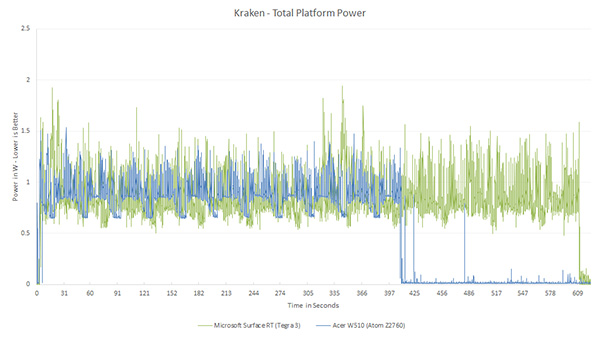
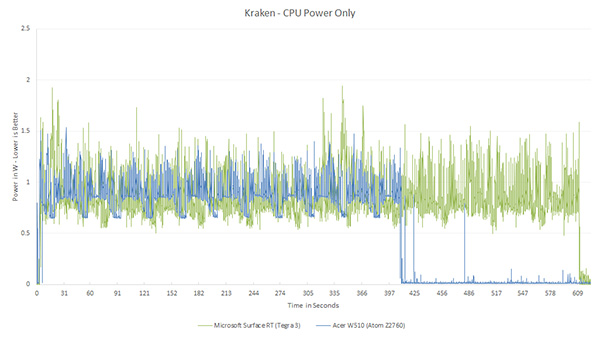

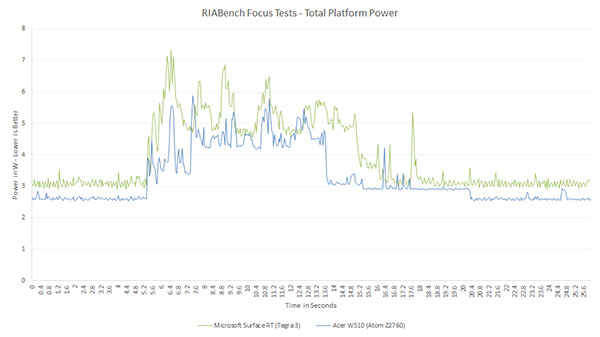
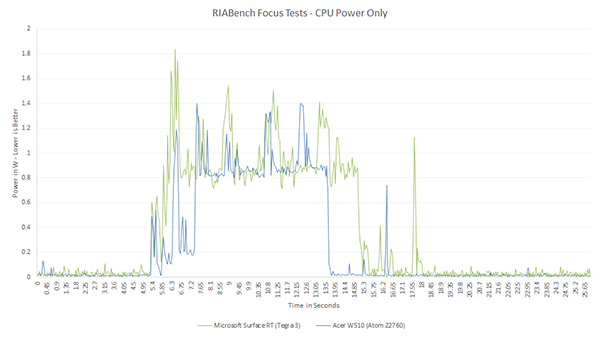
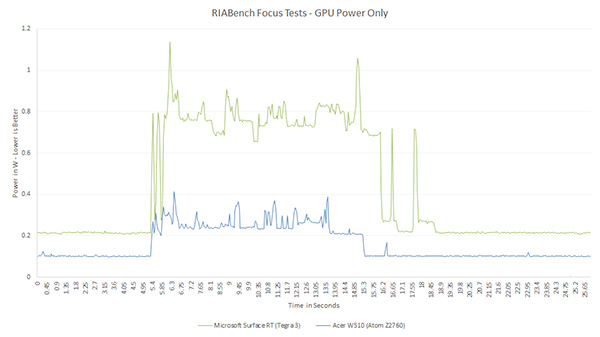








163 Comments
View All Comments
runner50783 - Monday, December 24, 2012 - link
This is why I don't care if you post your podcast on time : P, you guys are the best when it comes to technical analysis and reviews, you are the reference for the rest of the review sites, keep it up!Well, I guess graphics power may be the only advantage of tegra 3 over clover trail right now, and that may change with proper drivers too... Now it really makes little sense to have an RT based system, I feel bad for pulling the trigger on a Surface RT after playing with a Clover trail tablet, it was much faster on almost everything except games.
designerfx - Tuesday, December 25, 2012 - link
This is the first time in a long while that I've seen Anandtech declare that something which isn't accurately measured, is actually accurately measured and compared.I'm quite disappointed, honestly. 5th core on the Tegra is a significant part of what defines its power savings, and yet they're saying "Welp. It's about the same!".
I'm really questioning this a lot, Anand.
Deo Domuique - Thursday, December 27, 2012 - link
This is his yearly fat bonus by Intel :PAs for us, just ignore it and move on.
MrSpadge - Saturday, December 29, 2012 - link
What the ...?! If there's currently no way to enable the 5th core in Win 8, what exactly are they supposed to do? I'm sure Anand would love to repeat these tests if any way to fix this was available.. but right now that's how both devices perform. Call Tegra 3 crippled on Win 8 if you want, as that's what it apears to be.Activate: AMD - Saturday, December 29, 2012 - link
Whats the problem? They're comparing performance under the windows RT environment and Anand mentions on the very first page:"One last note: unlike under Android, NVIDIA doesn't use its 5th/companion core under Windows RT. Microsoft still doesn't support heterogeneous computing environments, so NVIDIA had to disable its companion core under Windows RT."
The only thing thats disappointing here is your inability to comprehend whats being tested.
Wolfpup - Thursday, January 3, 2013 - link
That would improve idle performance, but this is a real world test for the time being, and even still-Atom is more powerful, and yet uses less power, AND of course because it's more powerful, finishes doing work faster.Even if that fifth core were supported, this is still quite nifty.
The fact that I can, today, buy an actual x86 PC that can easily double as an iPad class ebook reader/light web browsing tablet is just amazing. (eInk's better, but you know what I mean).
Alexvrb - Thursday, December 27, 2012 - link
I'm not a huge fan of Tegra 3, but I wouldn't regret your Surface purchase too much. My dad has one, it's built better than any other tablet I've held. Plus Inte's solution is almost entirely unsatisfactory for 3D gaming. Intel is only using a single SGX 545 core. They clock it pretty high, but it isn't enough. The latest iPad uses a 4-core SGX 554 solution, and clocked right it seems to do pretty darn good on power too. Clocks aren't as high but it blows both the Tegra 3 and any ULV Atom out of the water.I'm not a huge fan of Apple either, but they generally use the most cutting-edge Imagination Technologies IP available. That might include Rogue (Series 6) in the next go around... Intel needs to get Series 6 in their chips ASAP.
Oh, and graphics drivers? Intel? Good luck! If this was Nvidia or AMD I might have agreed with you.
ssj3gohan - Monday, December 24, 2012 - link
This is really pornographic power electronics stuff. I do this stuff every day with my ultra-power efficient computer projects, but I didn't know that Intel walked around with this kind of a setup to show transparently what they are doing with power consumption.Good work, Intel. Now go and apply your knowledge to desktop platforms as well, because I'm kicking your ass here. I have yet to come across a desktop platform that cannot be made at least 50% more power efficient just through power electronics hacks.
madmilk - Monday, December 24, 2012 - link
Did anyone honestly think Intel, with a hundred times the revenue of ARM, would let themselves be devoured?Intel will still trouble entering the mobile device market because of the ISA lock-in ARM enjoys. On the other hand, ARM at this moment does not stand a chance in the (micro)server market either, especially as Intel increases its server Atom line.
tipoo - Monday, December 24, 2012 - link
Yeah, I think Intel will do fine and remain the 900lb gorilla in the mobile arena as well. ARM has the lead now, but once Intel has its sights set on something vital to its interests it tends to destroy the competition.